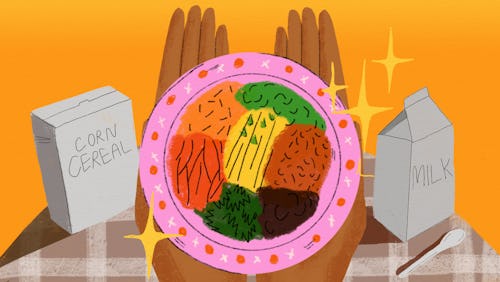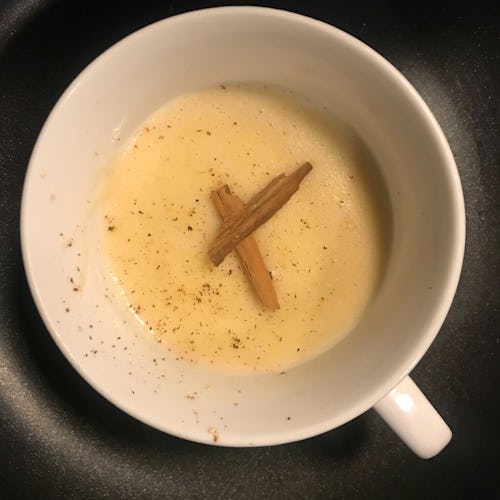
I remember a cavalcade of toothy celebrities on the front of the Corn Flakes box that I poured from each morning. For years, George Clooney as Batman, the Star Trek cast, or the Olympic Dream Team started off my day, their shiny, symmetrical smiles making me self-conscious about the way my own teeth had grown in. Across the dining table, my mom favored a sugar, corn, and milk spiced porridge favored in Haiti that remained unnamed to me because frankly, I was a jerk as a kid (or maybe, just trying to blend in at school) and didn’t care to know.
Whatever it was, it was not the crunchy, bland cereal a naive adolescent such as myself assumed Patrick Ewing or Larry Bird ate the morning they won their gold medals. American breakfast marketing, with its jingoistic aggressiveness, truly spoke to my developing brain every morning, leaving little room for an artsy, emotional, queer, nerdy child of Haitian immigrants by making me not want to show any of those traits to the world.
I learned in adulthood that the porridge my momma enjoyed is called akasan, also nicknamed “ak100,” because sounding it out in Creole, you'd say “Ah,” “Ka,” and “San,” or the number 100 (Haitians are so cool). It’s usually consumed as a breakfast made in advance, cold or warm for mornings on the go. Looking back at my side of the breakfast table, I always had a glass of orange juice, my cereal, a cup of hot coffee with milk (before iced coffee was de rigueur for the under-18 set), and a banana for breakfast. This quintessentially “complete breakfast,” the image of what your morning meal should look like, was burned into the brain of any kid watching a cereal commercial in the 90s.
As a theater kid, even though most marketing at the time was aimed towards white folk, I wanted to be the children in the ads, both literally and figuratively. Growing up, the scent of star anise and bay leaves, as yummy as they smelled coming from my mom’s mug, were never advertised to me as breakfast foods, and so I avoided what I perceived to be “foreign” to what I should aspire to. For years, I sat there silently reviling my mother’s mug breakfast, all while sitting with a bowl of processed corn doused with milk and sprinkled with sugar, not realizing the two dishes essentially contain the same three main ingredients.

Similarities aside, her breakfast was the antithesis of mine culturally, and I wanted to be what I thought this country wanted me to be — and that certainly was not an immigrant of color. My mother sipped Haiti, a place whose food culture I didn't know well enough to appreciate yet, from her cup while I sat thinking my American dreams would be found in my soggy cereal.
When Corn Flakes, the first corn cereal, was invented by anti-masturbation aficionados the Kellogg brothers, people were looking for an easy breakfast due to the Industrial Revolution making big midday meals impossible for workers. Cereal companies like Kellogg rode that wave, utilizing the imagery of happy smiling white faces, perfect little girls, and American heroes like Marines in their advertising from the very beginning, mirroring the dutiful and patriotic Uncle Sam mood of the day.
Cereal marketing in general is aggressive as hell. Fun fact: Did you know the mascots on most cereal box packaging marketed towards children, like my other childhood faves Cinnamon Toast Crunch, Froot Loops, Cocoa Puffs and others, are drawn with their eyes pointed downward so that they stare at kids in supermarket aisles? How is a child supposed to combat cereal psyops? That meal ideology had an effect on little me.
America, more than most other countries today, is best at cultural assimilation, or the process in which a minority group or culture comes to resemble a society's majority group. And my melting pot was actually a bowl where nothing melted, just soaked into sog. Cereal marketing made me want to be just like “everyone else.” Advertising has long been a vehicle for this, encouraging immigrants to adopt the mass produced as a marker of the white American lifestyle. You might think a strangely patriotic 1991 Coca-Cola commercial is just selling soda, or conversely, racists are just reacting poorly to this more recent and beautiful Coca-Cola ad, but the children of immigrants feel pressure to be good Americans.
Welp, American marketing was feeding me two scoops of lies. Ever notice that the strategically chosen celebrities on breakfast boxes look flawless? There’s a weird link between wholesome perfection and breakfast that is rather insidious. For instance, Vanessa Williams and Michael Phelps were removed from Corn Flakes boxes as soon as their perceived squeaky clean image was sullied by nudity and drug scandals. At multiple times in my childhood, this connected the food to morality in a way that Americans are experts at.
Further, American foods are not “cleaner,” healthier, or tastier than food elsewhere, so all that moralization is bullshit that’s hard for a young impressionable person to detect. In fact, cereal doesn’t even factor into the breakfasts of any of the world's healthiest countries. But my mom's asakan didn’t have the benefit of decades of indoctrination and endorsement from righteous American celebrities.
Sure, a bowl of cereal looks great alongside glasses of milk, orange juice, and a bowl of fruit, but that marketing strategy was used to distract from the fact that cereal doesn’t really contain much in the way of vitamins and minerals. The inventor of Corn Flakes himself, John H. Kellogg, was the first advocate of his cereal as a health food, but just to give you a fuller picture of his mindset, he was also the proponent of something called a 15-quart enema. My dude over here was basically one yoni egg away from being the 19th century Gwyneth Paltrow.
Breakfast marketing was feeding me two scoops of lies.
After decades of not engaging with the Haitian side of my culture, I realized a few years ago (as I rounded in my late 30s) that I still didn’t even know the names of manys of the enriching and delicious things my mother made. It began to bother me that I didn’t know how to make Haitian food like mayi moulen, another savory porridge that I used to eat growing up, but I know how to make pancakes from scratch without a recipe. This is not what I want for myself — my mother’s love language is food, and opening my heart fully to our culture is an important step in reaching true happiness for me.
To heal this damage, I’m going to try making other Haitian breakfast foods, like labouyi and Haitian eggs with yellow plantains, that I avoided as a kid — but also breakfast traditions from all the cultures that make this country a gumbo versus unseasoned casserole. Among those that sound delicious to me, personally, are tamago kake gohan from Japan or genfo from Ethiopia. I can still appreciate American breakfast as part of my growth, of course, but I’ve realized I have to expand my horizons if I’m trying to try and colonize my taste buds.
To start, I tried akasan for the first time. Last week, I enjoyed a chill evening with my mother where she taught me how to make it. We started by hydrating corn flour into a smooth velvety batter, pouring that into a pot of cinnamon, star anise, and bay leaves in boiling water so that the combo doesn’t form lumps (harder than it sounds — I messed up the first time and had to start over.)
Stirring constantly, once the mixture simmered for 15 minutes or so, my mom ladled a serving into a cup as I grated a bit of nutmeg over them, then we clinked our mugs and took a sip. As to whether I liked it or not, when I first took a sip of akasan, I realized the scent of its spices, warm corn flour, and sweet milk reminded me of my mom, still in her pajamas. I drank it again the very next morning.







